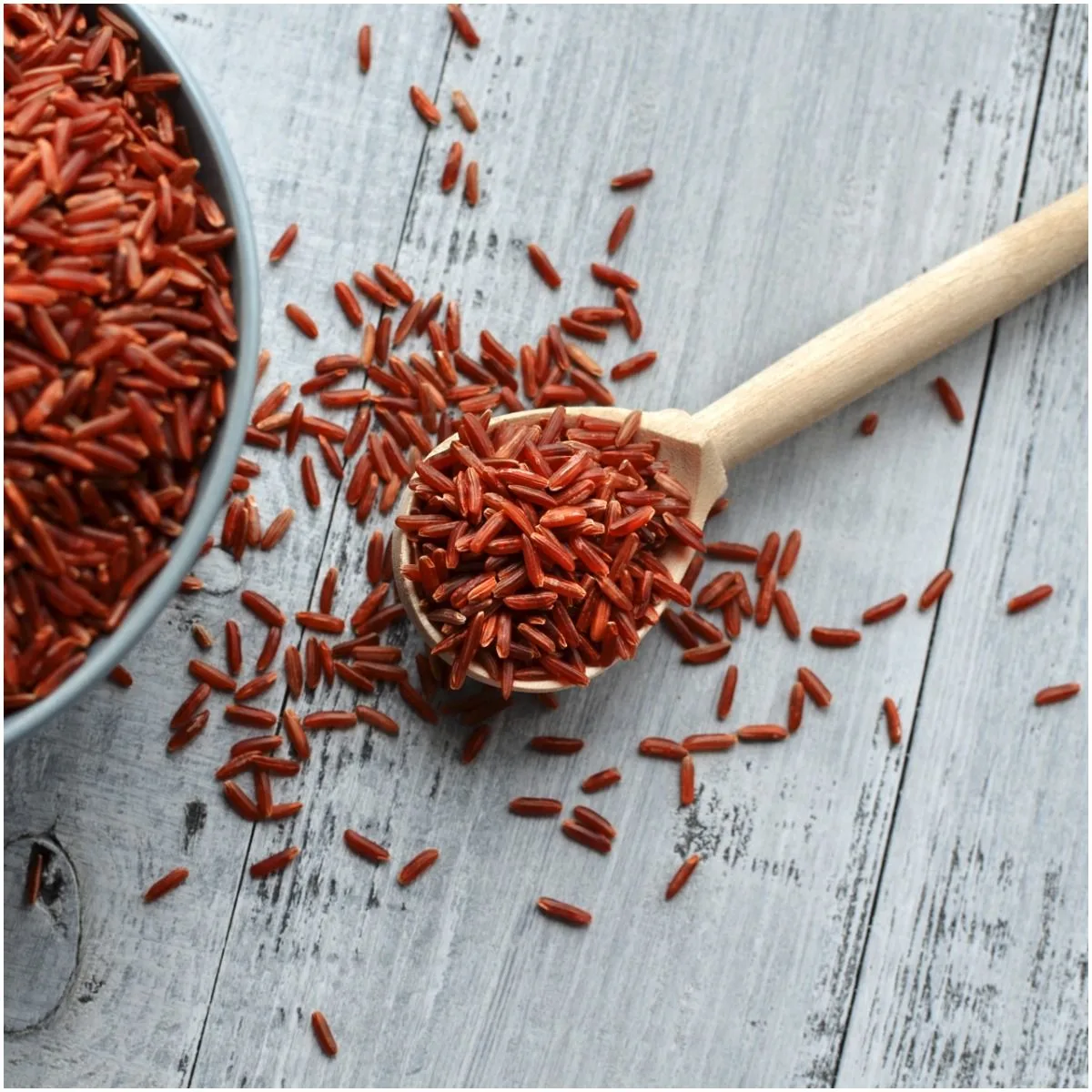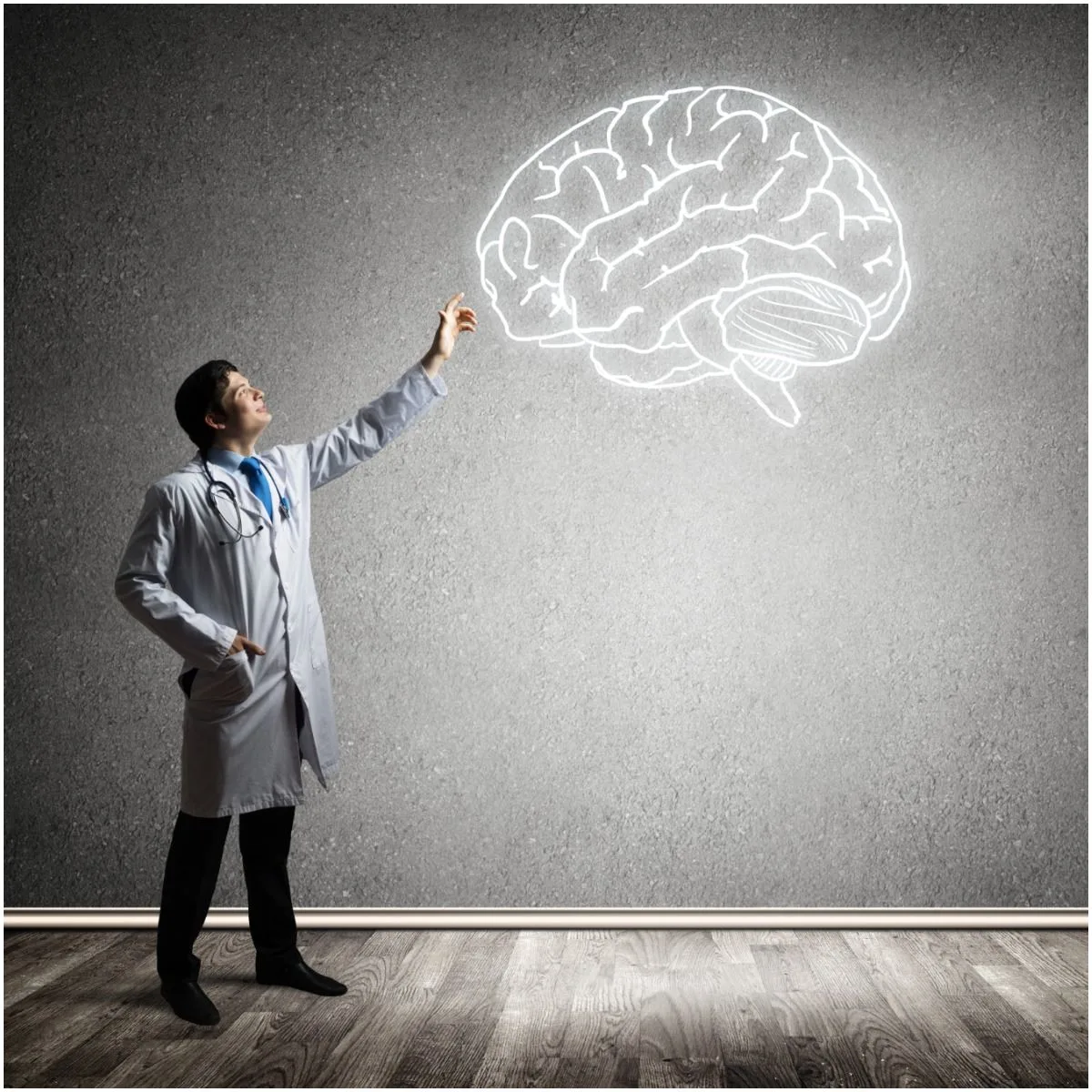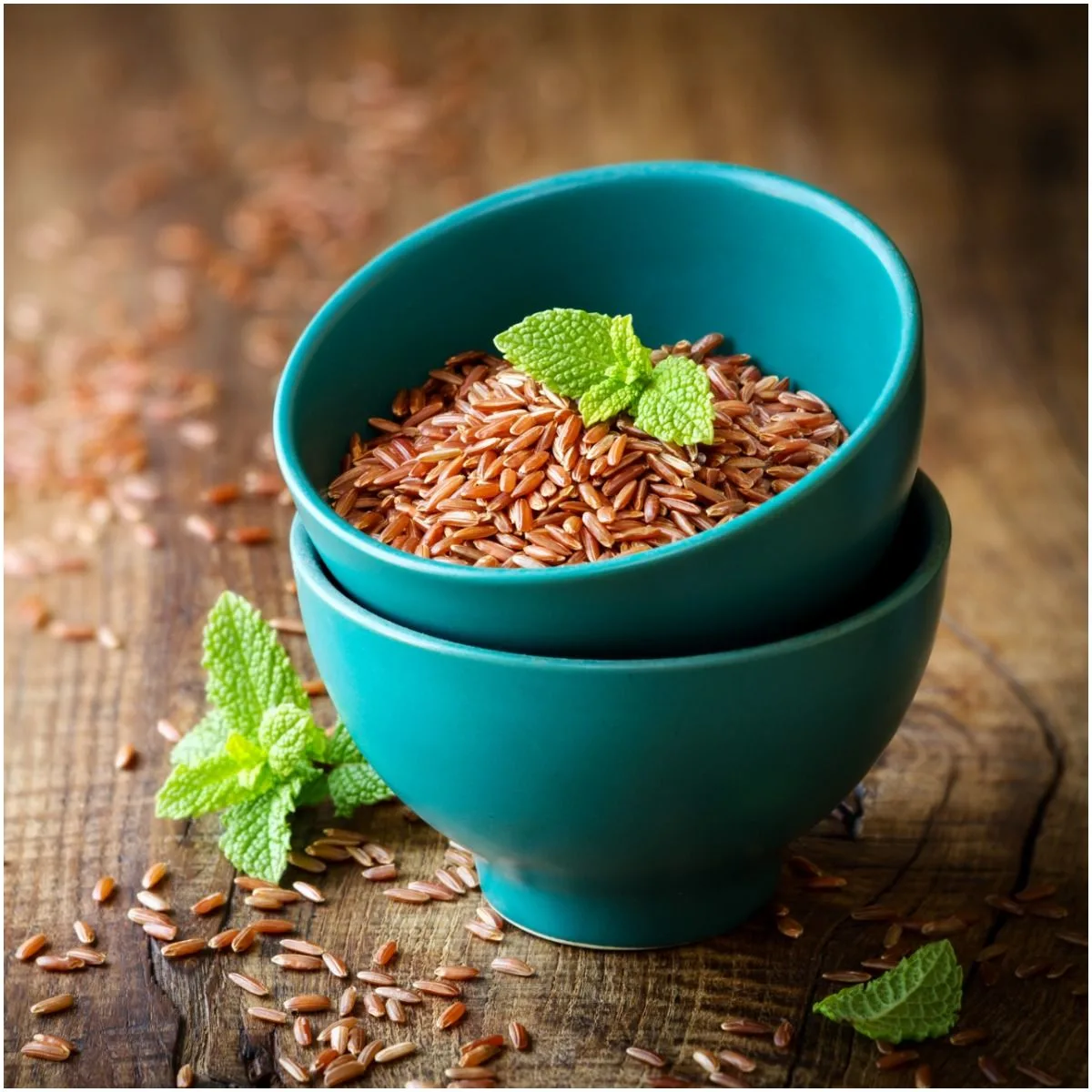Red rice benefits and side effects:
Short summary – Red rice is a nutrient-rich grain offering several health benefits. It’s packed with fiber, antioxidants, and essential vitamins and minerals such as Vitamin B6, iron, and zinc. Regular consumption of red rice can aid digestion, lower cholesterol levels, and help control blood sugar levels, making it beneficial for those with diabetes. However, it may have potential side effects like bloating or gas due to its high fiber content.
Introduction
Red rice is a type of rice containing pigments giving the hulled rice a red appearance.
Varieties of red rice include:
- Matta rice – it is cultivated in the Palakkad region of Kerala;
- Camargue red rice – it is cultivated in the wetlands of the Camargue region of southern France;
- Bhutanese red rice – it is a short grain, rosy-pink colored rice with a nutty flavor;
- Thai Red Cargo rice – it is a non-glutinous long-grain rice similar to jasmine rice;
- Rakthashali – it is a rare and traditional red rice variety.
Nutrition Facts
1 cup (about 164 grams) serving of cooked rice contains:
- 35 grams of carbohydrates;
- 3 grams of dietary fiber;
- 16,7 mg choline;
- 6.5 grams protein;
- 0.6 grams fat;
- 166 calories;
- 42 mcg folate (11% DV);
- 0.3 mg pantothenic acid (3% DV);
- 2 mg niacin (11% DV);
- 166 mg potassium (5% DV);
- 0.2 mg vitamin B6 (11% DV);
- 0.5 mg manganese (13%DV);
- 0.2 mg copper (10% DV);
- 134 mg phosphorus (13% DV);
- 0.1 mg riboflavin (8% DV);
- 0.1 mg thiamin (6% DV);
- 2.2 mg zinc (15%DV);
- 1 mg iron (5% DV);
- 1.3 mcg selenium (2%DV);
- 52 mg magnesium (13% DV).
Note – this grain derives its color from anthocyanins, phenolic compounds that are responsible for the color of innumerable vegetables, fruits, grains, and flowers.
Health Benefits

nika-lit/Shutterstock
Vitamin B6
It helps the human body in making neurotransmitters that transfer signals between nerve cells, making it an essential vitamin for the normal functioning of the brain.
Moreover, this vitamin is important for the breakdown and use of protein molecules as well as in the synthesis of glucose (sugar) within the body.
A deficiency in vitamin B6 may result in:
- kidney stones;
- convulsions;
- anemia;
- nausea;
- dizziness;
- skin disorders;
- smooth tongue.
Folate (Vitamin B9)
Vitamin B9 plays an essential role in cellular growth and maintenance throughout the human body in the way it influences DNA (deoxyribonucleic acid) repair and synthesis.
Folate is also involved in the creation and healthy function of neurotransmitters within the brain and many individuals report folic acid (the synthetic form of folate) to be beneficial for reducing brain fog.
Moreover, folate is essential for women who are pregnant since it prevents neurological birth defects and supports the growth of the baby. Neurological birth defects occur when the neural tube does not fully close during the first weeks of pregnancy.
Vitamin B9 is also required to metabolize homocysteine into methionine for muscular repair and growth. This is very important since elevated homocysteine has been strongly associated with an increased risk of stroke and heart attacks.
Since folate, like all B-complex vitamins, is vital for the growth of the cells that form skin, hair, and nails, having good levels of vitamin B9 in the body may improve the growth of these tissues.
Niacin (Vitamin B3)
Niacin (nicotinic acid), also known as vitamin B3, was the 3rd of the B-complex vitamins discovered. It is thought to play an important role in a variety of bodily processes. Therefore:
- it is important for psychological well-being;
- it helps reduce fatigue and tiredness;
- it is required for healthy skin;
- it helps to keep nerves healthy;
- it is needed to help release energy from food.
According to studies, vitamin B3 prevents and cures pellagra, a condition that is characterized by:
- inflammation of the mouth and tongue;
- mental confusion;
- dementia;
- skin lesions;
- diarrhea;
- sensitivity to sunlight.
Copper
It is an essential mineral for the proper functioning of many antioxidant enzymes, including superoxide dismutase. Also, it is a vital dietary nutrient as it helps to transmit electrical signals in the body and facilitates the absorption of iron.
Copper deficiency can manifest itself through many different symptoms, like:
- thyroid problems;
- birth defects;
- osteoporosis;
- brittle bones;
- irregular heartbeat;
- poor immunity response to infectious agents;
- frequent infections;
- low white blood cell count;
- enlarged veins;
- low body temperature;
- premature hair graying.
Zinc
Among its many functions, this essential trace mineral helps maintain a healthy immune system, plus, it is needed for DNA synthesis. Also, it helps create new cells that allow healthy collagen (the most abundant type of protein in the body) production.
Zinc deficiency during pregnancy can lead to:
- atonic bleeding (massive bleeding during puerperium);
- inefficient labor;
- prolonged gestation;
- abnormal taste sensation;
- increased maternal morbidity.
Riboflavin (Vitamin B2)
Vitamin B2 protects the body from infections and diseases and promotes immunity. In addition, riboflavin maintains healthy digestive tracts and strengthens the immune system.
Note – it is a water-soluble vitamin, one that cannot be stored by the human body except in very small amounts. Therefore, this vitamin must be replenished daily.
Deficiency symptoms include:
- signs of depression;
- increased anxiety;
- fatigue;
- swelling of the mucous membranes;
- sluggish metabolism;
- bloodshot eyes;
- nerve damage;
- burning sensation in the eyes;
- increased sensitivity to light.
Cancer Prevention
Red rice is an excellent source of insoluble fiber, a type of dietary fiber that protects against several types of cancer, especially colon cancer. Moreover, insoluble fiber helps reduce the risk of developing hemorrhoids in the large intestine.
This type of rice also contains resistant starch, a type of starch that is not completely broken down and absorbed by the body.
Resistant starch feeds the good bacteria in the colon and may help reduce bad (LDL) cholesterol over time.
According to recent research, resistant starch also:
- increases fat-burning;
- curbs appetite and reduces energy intake;
- helps with weights loss;
- improves muscle tone.
Brain Health

Khakimullin Aleksandr/Shutterstock
Red rice is a remarkable source of anthocyanins, flavonoids that have proven to be a potent group of antioxidants.
Anthocyanins provide the rice’s unique color. Additionally, anthocyanins have anti-carcinogenic activities and antioxidant properties, that help in type 2 diabetes mellitus and cancer prevention.
These flavonoids also fight oxidative stress, according to a 2010 report that was issued in Nutrition Reviews.
READ MORE: Sodium Benzoate (E211) – Side Effects
What About Red Yeast Rice?
Red yeast rice is a Chinese fermented rice product that some have claimed that improves blood circulation by decreasing triglyceride and LDL cholesterol levels in the body.
In 800 A.D., the Chinese first used red yeast rice as an aid for poor blood circulation and stomach ailments as well as to improve spleen health.
It contains monacolin K, a compound that is identical to lovastatin – the active ingredient in Mevacor, a prescription statin medication.
Individuals with high LDL and total cholesterol levels that used this supplement had lower bad and total cholesterols levels, according to a 2014 meta-analysis of 13 clinical trials.
Note – some red yeast supplements might contain only small amounts of monacolin K. This may lead to significantly poorer cholesterol levels properties of the supplement.
READ MORE: Sodium Metabisulfite – Side Effects
How to Cook
Add 1 cup rinsed rice to a large pot with 2 cups of water. Simmer and cover for 25 min. After, turn off the heat and set aside, covered, for 5 min. Allowing the rice to cool for a few minutes with the lid on gives it a firmer texture.
Tip
It is better to cook the rice in a large saucepan due to the fact that a larger cooking surface allows for heat to be evenly dispersed.
READ MORE: Tripotassium Phosphate vs Trisodium Phosphate In Cereals
Dangers of Red Rice

kuvona/Shutterstock
Consumption of red rice is likely safe, however, it is a leading dietary source of inorganic arsenic. This happens because rice plants absorb 10 times more arsenic than other plants.
The main sources of arsenic pollution include:
- coal burning and smelting;
- industrial waste;
- phosphate fertilizers;
- animal agriculture;
- wood preservatives;
- certain herbicides and pesticides.
Inorganic arsenic is known to be far more poisonous to humans than organic arsenic. It has a very long list of potential negative health effects, such as:
- lung cancer;
- birth defects;
- irritation of the skin;
- hypotension;
- vomiting;
- nausea.
Tip To Reduce The Arsenic Content
Soaking the rice in 6 parts water to 1 part rice, then, discarding the soaking liquid, and rinsing the rice properly, and then cooking in freshwater can remove up to 80 percent of the arsenic.
READ MORE: Cerasee Tea – Benefits
Side Effects of Red Yeast Rice
Similar to prescription statin medications, red yeast rice can cause side effects like – muscle pain, altered liver enzymes, and digestive upset. Also, it is linked with other side effects, like – abnormal liver function test results and myopathy.
Moreover, some red yeast rice supplements contain citrinin, a contaminant that can cause kidney failure.
Featured image credit – Shutterstock
READ THIS NEXT: E282 (Calcium Propionate) in Food – Side Effects
Sources https://nccih.nih.gov/health/redyeastrice https://www.mayoclinic.org/drugs-supplements-red-yeast-rice/art-20363074
